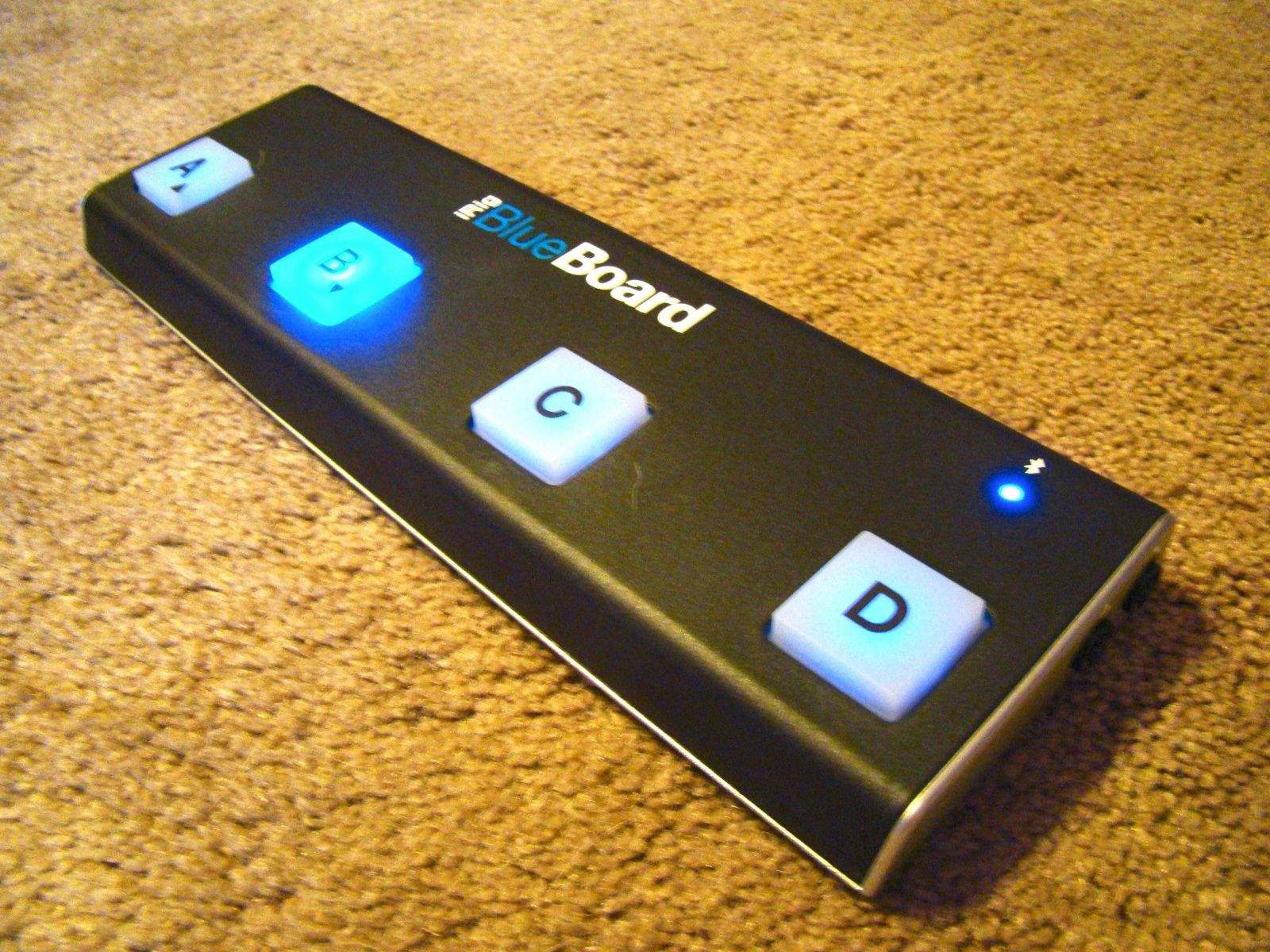Bluetooth Guitar Pedal Will Thrill Your Ears But Hurt Your Brain
IK Multimedia is responsible for a veritable boat-load of music peripherals and apps, like the hard-rocking guitar crunch of effects app Amplitube and the portable MIDI keyboard iRig Keys. If you’re a musician interested in working with iOS devices on stage, IK Multimedia is the place to go.
Category: Music Peripherals
Works With: iPad, iPhone, iPod touch
Price: $99.99
It was with excitement, then, that I opened the latest review gadget from the musical company, the iRig BlueBoard, a small footprint Bluetooth-enabled pedal board meant to help you switch effects in a guitar app like Amplitube or piano sounds in something like iLectric Piano, both IK Multimedia apps.
The BlueBoard is a great idea, especially if you’re working with a guitar or keyboard hooked up to an iPad or iPhone. Being able to switch settings on the fly with a foot-operated switch is something I do all the time with my analog guitar foot pedals. Having it do so via Bluetooth is even better, as it won’t take up the 30-pin or Lightning connector, leaving that free to connect a guitar or MIDI interface, like the iRig HD guitar adapter or the iRig Keys.
Unfortunately, that’s where the great idea stops and the difficult to figure out begins.
This post contains affiliate links. Cult of Mac may earn a commission when you use our links to buy items.

First of all, don’t get rid of the box your iRig BlueBoard comes in or you won’t be able to get it to work with Amplitube, the guitar effects app for iPad and iPhone. In order to do so, you’ll need the registration number that comes with the packaging. This number is not on the actual pedalboard unit itself, though there is a tiny QR code and some sort of number underneath it on the back of the board. It’s too small for my iPhone camera to focus on it or for my QR reader app to read it, let alone my aging eyes.
You’ll need to download a free app for the Blueboard itself, which makes it super easy to connect to the device. Once connected, though, it’s non-simple to figure out how to make the pedalboard, which uses MIDI signals to communicate with any of the music apps that support it, work with specific apps. Each app requires a different bit of settings tweaks to operate.
It’s unnecessarily complicated to make this work with the various apps and systems that it should work with.
To use the BlueBoard with AmpliTube, you’ll first need to dip into the BlueBoard app settings, change the MIDI mode to Control Change, hop over to AmpliTube, add your IK Multimedia account information with user name and password, and then enter the serial number of your BlueBoard (if you still have it). Then you’ll need to choose the type of AmpliTube effect you want to control with the board, enable the effect in one of the slots, and then click and hold on the on/off button for three seconds. Then, you’ll get a window to assign control to one of the pads on the iRig BlueBoard itself.
You’ll need to do a similar amount of settings tweaking to get the BlueBoard to work in iGrand Piano, including changing the mode in the Blueboard to Program Change (instead of the above Control Change) and then drop into the settings for iGrand Piano to set the MIDI Channel to Omni, which lets it listen on all MIDI channels.

See what I mean? It’s unnecessarily complicated–at least, from a consumer point of view–to make this work with the various apps and systems that any one of us might want to use it with. I couldn’t figure out how to make this work with GarageBand, either.
It’s a shame, really, because the BlueBoard is a delightfully designed piece of hardware. It’s solidly built and has nice stage-friendly low-intensity blue backlighting to the four pedal buttons on the face of it. It runs on four AAA batteries, which is great for when you forget a power cord, but it can also work with a micro USB cable for power as well. There are two extra instrument controller ports on the side so you can integrate BlueBoard into your current stage setup with ease.
Once you figure out how to make the BlueBoard work with your favorite effects or instrument apps (there are no instructions in the manual that comes included with the device), the iRig BlueBoard is a fantastic bit of stage kit, allowing you to make changes to your sound and setup on the fly, without having to remove your hands from your instrument. If IK Multimedia can make things a bit more intuitive on the software side, I’d give the iRig BlueBoard a wholehearted recommendation.
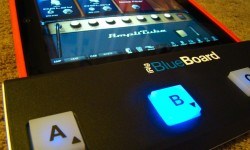 Product Name: iRig BlueBoard Product Name: iRig BlueBoardThe Good: Well-designed hardware; perfect for the iOS-enabled musician on the stage or in the studio. The Bad: The software is difficult to figure out, and there are way too many individual settings to tweak to make it all work; not having the product serial number on the device is an oversight that needs fixing. The Verdict If you save the box and figure out the settings tweaks within each music app you want to use this device with, the iRig BlueBoard is a great way to control your iOS-powered MIDI apps. Buy from: IK Multimedia |

[rating=good]
iLoud Bluetooth Guitar Speaker Rawks
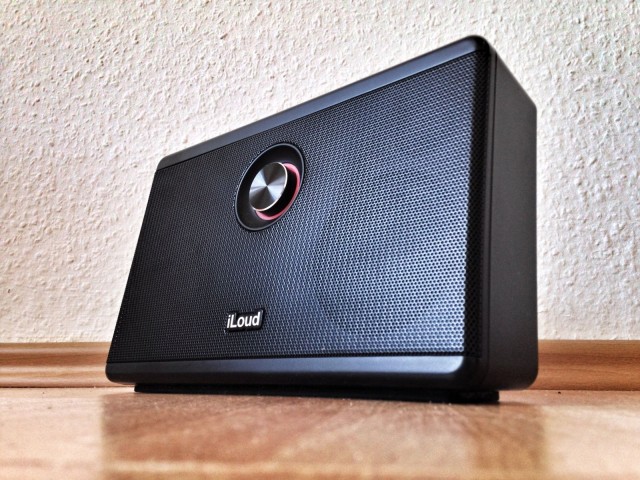
Category: Speakers
Works With: Anything
Price: $300
To save time, here’s my advice: If you have an iPad or iPhone, a guitar and $300 to spend, then spend it on the iLoud. It’s a small, portable Bluetooth speaker that is way louder than any other Bluetooth speaker, and it lets you plug in your guitar and use your iPhone – wirelessly – to add effects using an app like IK Multimedias’s AmpliTube.
More importantly, the iLoud rocks.
What It Is
The iLoud is a portable, battery-powered studio monitor speaker, which is to say that its sound is uncolored and without bias toward extra bass or punchy vocals. The idea of a studio monitor is to be as neutral as possible.
It packs 40 watts, which doesn’t sound like much if you’re used to the way speakers were measured back in the 1980s and ’90s, but is plenty loud enough in real life. In fact, I couldn’t ever really get the thing up to full volume as I’m scared to annoy my neighbors, who hate me enough as it is.

You pair your iDevice (using the dedicated pairing button on the back) and control the volume from the giant, red-lit knob on the front. And you can leave it there if you like.
But there’s another trick. If you plug a guitar into the quarter-inch jack socket on the back and fire up the AmpliTube app on your iPhone or iPad, the sound from the guitar will be sent to the app, processed by whatever amp and pedal effects you’ve dialed in, and sent back to the speaker. And thanks to Bluetooth, this all happens without a delay. I was testing using a Fender Strat plugged and a Retina iPad mini and I noticed no delay whatsoever (except when I dialed in a delay pedal ba-dum-TISH).
The Good
The sound of the iLoud is as clear as you like. I tried it next to the $400 Wren AirPlay speaker and it comes out looking great. The bass of the Wren is a little richer (it’s likely tuned to sound more pleasant), but the iLoud punches out just as much low end, and it seems more controlled, too.

In fact, the speaker is precise across the range, and copes well with classical, acoustic guitar and rock, as well as electronic music. I decided I could spend a few minutes scaring my neighbors, so I played Hendrix’s “Voodoo Chile (Slight Return)” (the last track on Electric Ladyland) far too loud and it duly rocked. Hard.
The speaker is also tough. Before I discovered the flip-out stabilizing foot in the base, I kicked it over far too many times, and it’s still working (and looking) great. I also like the big knob for volume, although I don’t like the red light around it. If I was playing onstage, though, I’d appreciate this always-on power indicator. Speaking of power, the 10-hour reported battery life sounds about right, or maybe a little optimistic. It really depends how loud you crank it.
The Bad
A bigger problem is the fact that the battery seems to die even when you’re not using the speaker. Leave it switched off for a week and when you toggle the switch on the back, nothing happens. You have to plug it into the mains to get it to fire up. However, if you leave it plugged in for just a few minutes and then unplug it, the battery seems to be full, or at least a lot better charged than it should be after just a couple minutes.
This makes me think that the speaker is just getting confused, and only thinks it’s dead. Kind of like an actual rock guitarist, I guess.
The other thing that drove me crazy was the Bluetooth connectivity. Usually, once a speaker has been paired, it’ll show up in the AirPlay menu on your iDevice whenever it’s switched on. Not so with the iLoud. I have to open up the Bluetooth prefs and select it in that list, waiting for it to connect every time. It’s like the bad old days of iOS 6 all over again.
The Verdict
Like I said at the top, the iLoud is an amazing bit of kit. These days I only play the guitar if I find one in somebody else’s home (I borrowed one for this review), but I used to play, and I had my own sweet combo amp and a few pedals and a rocking old Charvel Jackson. If you could have shown my old 1986 self this tiny speaker and an iPad running the AmpliTube app, I would have swapped my old Sessionette 75 and my Boss pedals for it in a second.
Plus the iLoud doubles as a great speaker for music and movies. A real all-rounder. Considering this, $300 seems like a steal.
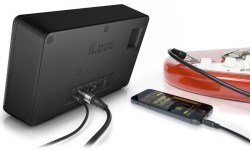
Product Name: : iLoud The Good: Loud, clean, pretty. The Bad: Battery drains even when off. The Verdict: A fantastic practice rig, and a pretty good all-round speaker. Buy from: IK Multimedia |
[rating=excellent]
Use The Essential iKlip 2 Any Time You’re On Stage With An iPad
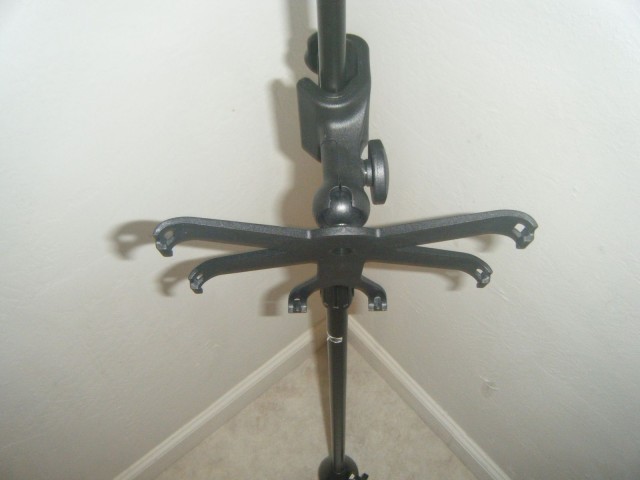
Time to come clean: I play guitar and sing in a disco band. I know, I know, the backlash against that kind of music has been going on since 1977. Trust me, I know.
But the way people respond to this still-valid, we-use-real-instruments form of music is so much better than the way they used to when I played guitar in modern or classic rock bands. In those days, the most reaction I’d see in an audience was a foot tap, or maybe–if I was lucky–a head bob or two. Happy, gorgeous people dancing their butts off? So much more fun.
Category: iPad Cases & Accessories
Works With: iPad 2, 3, 4
Price: $39.99
Now, playing in a cover band requires knowing a lot of music, like the chords for the 50 plus songs that we play. As I also take on half the lead singing duties, so I’m required to know the lyrics as well. I don’t do this for a living; I do it for fun and some beer and gear money. I don’t have tons of time to memorize all those songs, let alone the new ones we learn every few months. So I use lyric sheets. I used to use them on paper, but boy is that annoyingly old school and easily lost.
Now I use my iPad (and an amazing app called GigBook) to organize and keep track of my lyric sheets. And I also use the incomparable iKlip 2 iPad holder to attach that iPad to the microphone stand right in front of me.
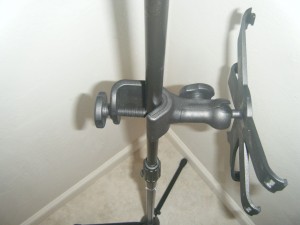
The iKlip 2 is a refinement of everything great about its predecessor, the iKlip. That one was made to hold the original iPad, and I used it for quite some time. This new iPad holder, though, has some improvements, like the ball and socket connector that allows a wide range of positions for the iPad when in use on stage or in rehearsal.
Most of the time, I connect the part that attaches to the mic stand just above the place where the stand can extend upward, and then slide my iPad 3 into the loving arms of the iKlip 2, which then holds my iPad safely in portrait orientation. One thing the older iKlip couldn’t do was to rotate from that orientation to a landscape one: the iKlip 2 does this super easily with a simple loosening of the ball and joint screw lock. That alone is worth the cost of the iKlip 2, but there’s more.
There’s really nothing bad to say about the iKlip 2; I’ve been using it for a good few months.
With that ball and joint connector, I can connect the iPad stand to the top of the mic boom stand, and have it just above the whole stand, leaving it easily in front of my eyes. This works great for rehearsal, but tends to obscure my beautiful face from the audience while on stage. I can totally see this configuration working well for musicians who need their music up top and center, but who don’t need to be seen by the audience.

If I had a second iPad and used some of the great iKlip apps for my guitar, I would immediately grab another iKlip 2, since I could connect the second iPad lower down on the mic stand and connect a foot pedal and my favorite guitar effects app to the iPad that would then nestle carefully in the second iKlip 2. The possibilities are endless.
There’s really nothing bad to say about the iKlip 2; I’ve been using it for a good few months and it still tightens well, hasn’t let my iPad fall to the ground (not once!), and continues to serve me and the band well. For $40, this is a no-brainer if an iPad is needed on stage or attached to a mic stand in any way.

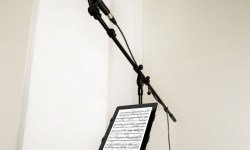 Name: : iKlip 2 Name: : iKlip 2The Good: Solidly constructed, improves on its predecessor in every way; easy to position and re-position, yet stays tightly connected. The Bad: Not much to report, here. The Verdict Bottom line, the iKlip 2 iPad stand for microphone stands is the best way to connect an iPad to a mic stand for stage or rehearsal. Buy from: IK Multimedia Buy from: Amazon |
